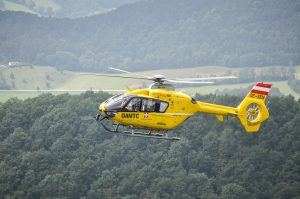An essential safety factor in flight rescue is the optimal support of the pilots by the flight rescuers during the different flight phases. For this reason, regular cockpit training has been required by law at European level not only for pilots but also for flight rescuers since 2022.
"In the course of this training, it is checked whether pilots can control their aircraft in emergency situations and react correctly," explains Reinhard Kraxner, Managing Director of ÖAMTC air rescue. In the simulator, wind and weather conditions as well as emergencies - such as system failures or problems with navigation - can be recorded and trained as often as required. "In this way, pilots and flight rescuers can familiarize themselves with the flight characteristics of the helicopter in a safe environment, practice flight maneuvers and work through incidents together," says Kraxner.
In cooperation with RotorSky, the market leader for helicopter training in Austria, a highly modern and type-specific flight simulator has now been set up in Linz/Hörsching. “In Upper Austria we are all working together towards one major goal: that Upper Austrians can live well and healthily. The Christophorus crews are indispensable for the emergency medical care in Upper Austria,” states health officer LH deputy Christine Haberlander. "The new simulator makes it possible to train realistically and to prepare optimally for future missions." The central location of the education and training offer at Linz Airport also makes this interesting for pilots from all over the world. "Through the resulting numerous hotel accommodations, he also contributes directly to the added value in the region," says Haberlander happily.
Until now, comparable simulators were only available in Germany and Norway. "This Austrian solution now gives us the opportunity to organize necessary training more flexibly, efficiently and cost-effectively," adds Marco Trefanitz, spokesman for the management of ÖAMTC air rescue. The trips that pilots and flight rescuers have to make several times a year have so far involved immense human and financial expenditure. “Participants can travel to the new simulator publicly. This has enabled us to significantly reduce travel-related CO2 emissions,” explains Trefanitz. "And training in the simulator does not cause any noise or pollution for the environment."
And the new simulator has another advantage. While international scenes have been used up to now, the virtual flight now goes over one's own homeland: "This allows the Christophorus crews to fly to their home landing sites, such as the heliports on the roofs of the regional hospitals or their own bases," says the ÖAMTC's country director Upper Austria, Harald Großauer. "I am also pleased that this simulator was built in Upper Austria."
The cooperation between the ÖAMTC air rescue service and RotorSky guarantees an optimal exchange of experience, because the existing know-how of both cooperation partners can be accessed at any time. In the future, the teaching staff of both flight schools will be used together in a wide variety of training projects. "Both RotorSky and ÖAMTC air rescue have unique expertise in their respective fields," says Christian Gruber, CEO of RotorSky. "It was therefore a logical step to combine our competencies in order to develop and implement well thought-out training solutions."




